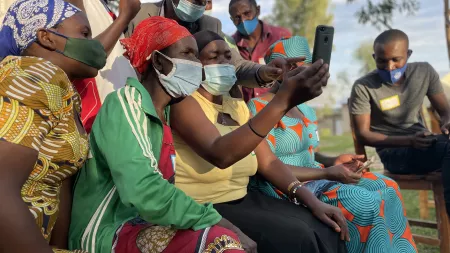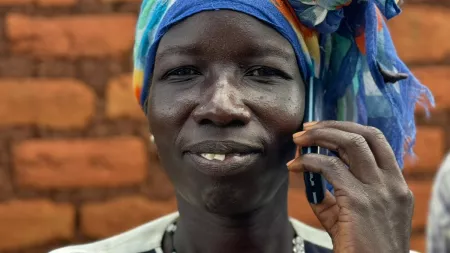As our world advances digitally, so does the digital divide, depriving a section of the population of skills critical for navigating everyday life. Women are globally 17% less likely to use smartphones than men and 16% are less likely to use mobile internet.
These barriers are particularly prominent for members of Village Savings & Loan Associations (VSLAs) who tend to be from the lowest-income communities. Additionally, discriminatory gender norms limit women’s ability to acquire basic digital skills and access to and use of technology.
To address women’s digital exclusion, CARE implemented a comprehensive strategy, focusing on providing digital tools and skills to VSLA members. This initiative, funded by the Sall Family Foundation, launched in September 2022 across 50 groups in Uganda and 50 groups in Rwanda, includes efforts to combat discriminatory norms, facilitate device access, and offer digital training.
CARE is doing extensive research to inform and enhance these programs.

What did we learn from the research?
- Husbands are the primary gatekeepers for married women
When women were asked to identify the biggest barriers to their regular use of mobile phones (cost, ownership, relevance, or something else). Male partners were consistently cited as the primary barriers due to their control over female partners in addition to gender norms that limited their asset ownership and decision-making.
- It is dangerous to put phones in women’s hands when their partners do not have one
In households where women possess more valuable assets, like smartphones compared to their husbands' basic phones, suspicions of infidelity or outside influences arise, potentially leading to gender-based violence. Female phone ownership disrupts traditional power dynamics, with men viewing it as a threat to their authority.
- Affordability is a problem for urban groups. Relevance is the issue for rural groups
In urban areas where the environment for using basic smartphones is well-established, mobile ownership is high, and individuals are better positioned to decide the relevance of technology in their lives. Conversely, in rural areas, exposure to and awareness of smartphone technology is limited. Factors such as access to agents, data and connectivity act as significant barriers.
- Group members place low emphasis on girls’ education
Levels of education are directly related to digital use and control through literacy and numeracy levels, and financial capability.
- Local partners and CBTs could benefit from training on gender transformative digital capability messaging.
CARE partners and Community Based Trainers (CBTs) have deep understanding of the social context and further training on discussing technology with households, particularly with men who are reluctant for their wives to own phones could be helpful.
What are we doing next?
The research and pilot played an integral role in understanding the holistic approach to embedding these communities into the digital economy. As we move ahead, we are:
- Aiming to bridge the digital divide, especially for women, and marginalized communities not just by introducing digital tools but by embedding these communities into the digital economy, ensuring no one is left behind in the digital era.
- Not just equipping individuals with technology but transforming how VSLAs function in an increasingly digital world.
- Equipping participants with the skills to safely and effectively navigate the digital landscape.
- Constructing a sustainable model that can be replicated in diverse settings, ensuring an inclusive digital future.
- Consolidating feedback from participants and stakeholders and analyzing pilot data to gain deep insights into program’s effectiveness.
- Refining our training models leveraging these insights to address gender gaps and challenges identified.
- Exploring opportunities to scale-up.
- Continuing to actively engage with and listen to communities and recognize that digital literacy extends beyond mere access to technology.
- Working towards constructing a sustainable model that can be replicated in diverse settings, ensuring an inclusive digital future.
- Building a digital ecosystem where every individual, irrespective of their starting point, can connect, grow, and thrive.
- Developing digital tools to help women overcome existing barriers and creating strategies to address social norms related to device ownership and use.
Want to learn more?
Check out the research report.
